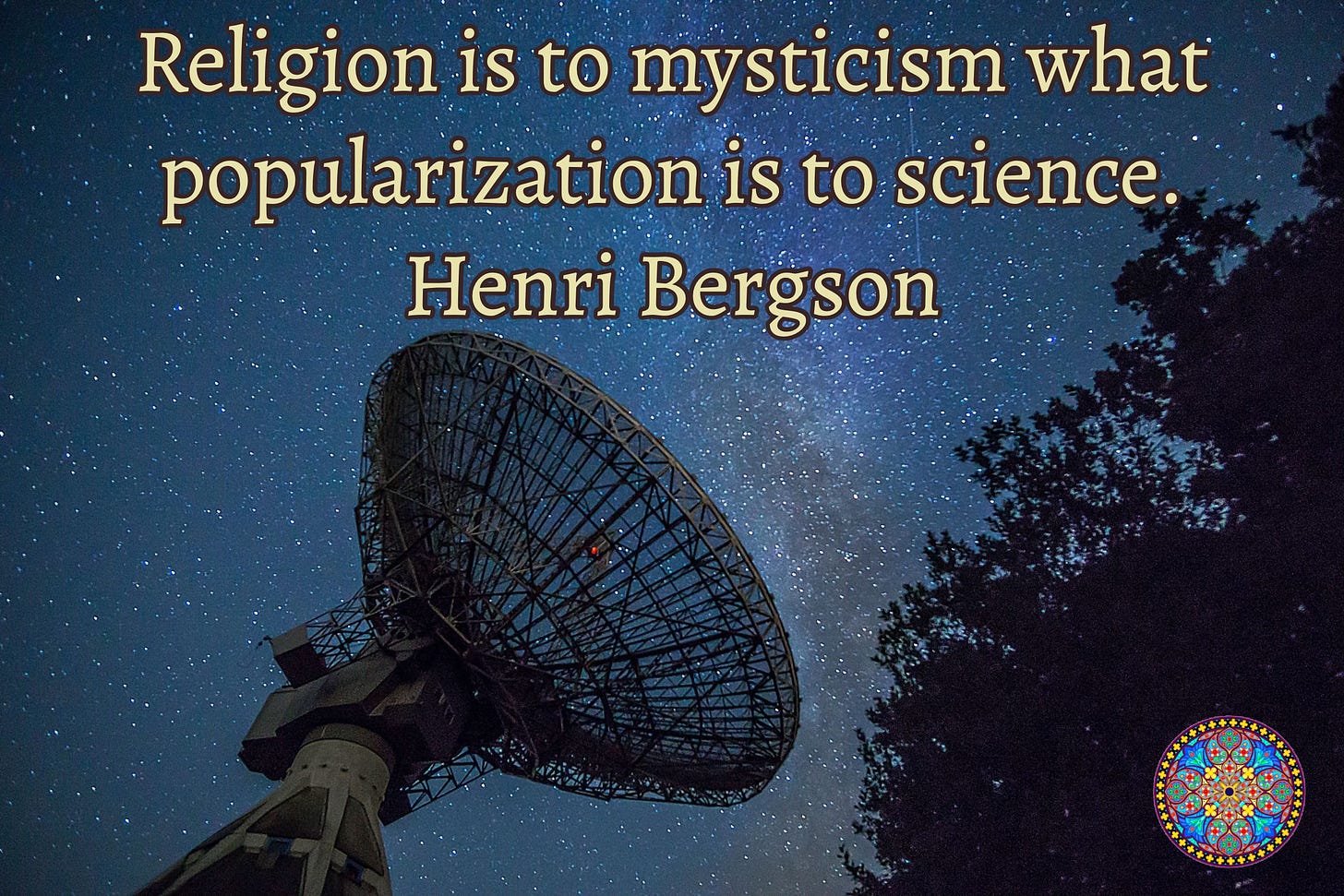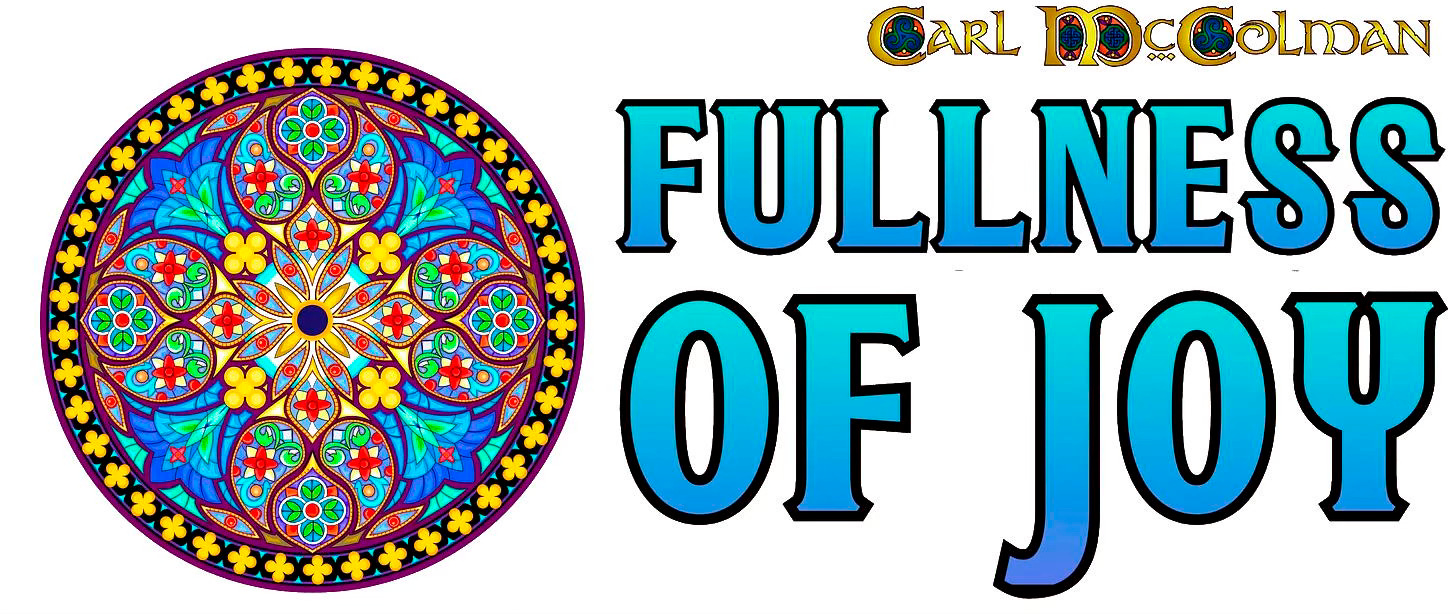How to be a Mystic (According to the Mystics)
A Template for Contemplative Living Based on the Hebrew Scriptures
Karl Rahner, the renowned German Jesuit theologian who was one of the more prominent figures at the Vatican II Council in the 1960s, famously said:
“The Christian of the future will be mystic or will not exist.”
Rahner died in 1982, leaving us with a question that some might find challenging: is the future that he warned us about already coming to pass?
According to the Pew Research Center, Christianity in America has suffered from “many years of steady decline.” A simple glance at the numbers bear this out: in 1965, over 85% of the population of the United States (one of the most religious nations in the Christian world) identified as Christian, while by 2023 that number had dropped to about 62%. Meanwhile, the average age of people who regularly participate in religious activities has climbed steadily, implying that the younger you are, the less likely you will identify as a Christian. And while Pew research indicates that the decline “shows signs of leveling off — at least temporarily,” the evidence also suggests that many of the young people who are currently drawn to Christianity (particularly white men) are interested in the faith as an expression of their political beliefs. Given the mercurial nature of American politics, it may be safe to assume that the larger and longer trend of decline is not likely to reverse any time soon.
These statistics seem to suggest that Rahner’s ominous prediction about Christians “not existing” is not a description of some distant future, but is actually a present reality.
But let us consider the other side of Rahner’s prophecy: if there is to be a meaningful faith in Christ for the future, perhaps it will come to us largely through the wisdom and spirituality of the mystics — persons of every generation who prioritize an embodied, experiential faith over the more abstract practices commonly associated with religious observance (like Bible study or corporate worship). While historically mystics have often participated in the ordinary practices of the Christian faith, they have always grounded their spirituality in meditation, contemplation (and contemplative prayer), and a commitment to interior transformation to foster a life oriented toward compassion and service as an expression of a loving bond with God.
The French philosopher Henri Bergson offered an interesting analogy:
“Religion is to mysticism what popularization is to science.”
Popular science is the ordinary wisdom of the everyday person on the street, unlike the “pure” science of university researchers. Likewise, Bergson’s view regards ordinary religious observance as a cultural expression of belief in God, whereas the contemplative or mystical life asks more of us — a greater commitment to daily meditation, intentional silence, and prayer as a practice of seeking intimacy with God — but it also promises more, in terms of an experience of the fruit of the spirit (a greater sense of love, joy, peace, as abiding qualities of a spiritual life) and even the possibility of a felt, conscious sense of the presence of God (what many mystics have called “union with God”).
If a mystic is someone who seeks to have a meaningful and committed experiential encounter with God, then more questions arise: how does somebody become a mystic? What does a mystical life look like, especially over the human lifespan? These are questions that the mystics themselves have attempted to answer.
Becoming a Mystic
To consider how the mystics understand the mystical life, we can go all the way back to Origen of Alexandria, an Egyptian theologian, Bible scholar and mystic who died in the middle of the third century, making him one of the earliest of the great Christian mystics. In his book The Origins of the Christian Mystical Tradition, British Orthodox theologian Andrew Louth describes how Origen understood the spiritual life to move through three stages: purification, illumination, and union. Origen based this spiritual “map” on Stoic philosophy but also on his interpretation of three books in the Hebrew Bible that were traditionally believed to have been written by Solomon: Proverbs, Ecclesiastes, and the Song of Songs.
As Origen saw it, the spiritual life begins with a process of inner purification or purgation, that can be seen in terms of moral development or ethical growth. The book of Proverbs, as a collection of pithy statements designed to foster righteous or moral living, is emblematic of this stage. Following purification, the next stage is “illumination” or the development of insight and wisdom, which Origen compared to the attainment of natural philosophy, symbolized by the existential wisdom of the book of Ecclesiastes. But beyond ordinary insight and wisdom comes the final stage of union—union between the human and the divine—which corresponds to the metaphor of spirituality as romantic or even erotic love, corresponding to the lush and sensual love poetry found in the Song of Songs.
This three-stage model of the spiritual life proved to be hugely influential within the scope of Christian history. A few centuries after Origen, the Neo-Platonist monk and theologian known as Dionysius the Pseudo-Areopagite uses the template of purification, illumination and union to illustrate his hierarchical understanding of spirituality. And while other mystics have described other ways of understanding the spiritual life (famously, the Spanish Carmelite nun Teresa of Ávila compared the mystical life to a series of seven “mansions” or rooms in a castle, each one representing a different characteristic of spirituality), the model of purification/illumination/union has remained the most widely used description of spiritual growth, still influential even into the twentieth century. The British mystic (and scholar of mysticism) Evelyn Underhill, in her book Mysticism: A Study of the Nature and Development of Spiritual Consciousness, expands Origen’s ideas into a five-stage model of spiritual growth:
Awakening (or conversion);
Purification;
Illumination,
The “Dark Night of the Soul” which represents a kind of deeper purification;
Union.
More recently, the American Episcopal Theologian Robert Davis Hughes III in his book Beloved Dust: Tides of the Spirit in the Christian Life, structured his study of mysticism around the three “tides” of purification, illumination and union, offering a very post-modern twist: seeing these movements not as a hierarchical progression (like rungs on a ladder), but in a more circular way as the tides of the ocean: with each movement of ethical growth, the cultivation of wisdom, and the joy of divine intimacy representing spiritual stages or movements that can repeat themselves over and over as we mature in our spiritual life. In the words of the Apostle Paul, this is to “know this love that surpasses knowledge—that you may be filled to the measure of all the fullness of God.” (Ephesians 3:19). The Second Letter of Peter is even more daring, describing the life of faith as becoming “partakers of the divine nature (II Peter 1:4), language that echoes the mystical concept of union with God.
Practical Mysticism, or, Living the Three Paths
To become a mystic means simply to enter into a conscious and intentional spiritual life where personal transformation, the cultivation of wisdom, and the experience of divine love are sought and embraced. The tricky part, of course, is that “divine love” is not something that we can easily command to become manifest in our lives. If we take seriously the religious sense that God, or the Spirit, exists not to serve but to be served, then we have to question if our desire for divine union is truly a desire for mystical union, or could perhaps represent a more consumerist idea of seeking God for God’s entertainment value.
Just as we cannot force another human being to love us or even like us, so we cannot presume to make God consciously present in our lives, in a manner that we clearly can feel and experience. Christian theology is clear that God loves us, but this does not guarantee that God’s love will translate into a felt experience. Herein lies one of the great mysteries of mysticism: a belief that God desires intimacy with us, but that we cannot evaluate God’s presence in our lives on the basis of what it feels like. After all, some persons’ experience of God might be simply an expression of their active (or over-active) imagination, while others might say they have never felt or recognized anything that they would describe as an “experience” of God, yet they conduct their lives with such heartfelt joy, kindness, compassion and wisdom that any thoughtful observer would likely conclude that they are truly spiritually mature, if not genuine mystics of the first degree.
Historically, this has meant that the mystical life is understood as including two dynamics: the intentional choices and commitments of the individual who seeks mystical union, and then the inexplicable action of the Spirit in that persons’ life, understood to be an expression of pure grace (a gift of love that cannot be earned or controlled), but because it is pure grace, it might show up in a person’s life in a way that is surprising and unexpected. How God’s love is experienced is probably unique to every single human being.
If you want to live a mystical life, one way to approach it would be in the spirit of the Serenity Prayer by Reinhold Niebuhr, and made famous by the Recovery Community:
“God grant me the serenity to accept the things I cannot change, courage to change the things I can and wisdom to know the difference.”
Notice how this prayer seems to echo Origen’s model of the mystical life: the courage to change is the key dynamic of purification, the wisdom that can discern is the fruit of illumination, and serenity embodies the unending love celebrated in the Song of Songs.
With this in mind, we could see the spirituality of purification as very much something we can change about ourselves; the spirituality of illumination might be more a matter of grace and less a matter of human control, and the blessings of divine union can be seen as entirely a fruit of the Spirit’s initiative: not something that we can change by our own initiative.
Changing What We Can
The traditional language of purification, found in the classic writings of mystics down the centuries, can sometimes come across as harsh and even dualistic. Historically, there is a long tradition within Christianity of equating “purification” with disciplining of bodily appetites and desires. Since many of the leading contemplative and mystical figures within Christianity were celibate monks, nuns and priests, there has been an unfortunate tendency to equate spiritual transformation with adopting a strict sexual chastity — an unfortunate legacy that has manifested in Protestant and Evangelical communities as well, such as the “Purity Ring” movement in recent American Christianity. Clearly, for many spiritual seekers of our time, it is clearly dualistic to link care for the spirit with chastisement of the body.
So to be a “mystic of the future” one task facing us is to create new models of what spiritual purification entails. Instead of repressing or rejecting sexual desire and expression, we may need to think in terms of “purging” ourselves of dualistic thinking, of prejudice and systems of oppression and privilege, of egocentric “programs of happiness” — Thomas Keating’s language to describe patterns of thinking and behavior that are self-defensive and based on fearful or prejudicial ways of seeing the world, rather than the kind of open-hearted, trusting, compassionate, loving, and merciful values and behaviors that are traditionally associated with saints, sages and bodhisattvas. Just because thoughtful Christians today reject old ways of thinking that are dualistic and fear-based, that does not mean there is no room for personal or social transformation in the spiritual life. On the contrary, the call of mysticism is a radical call to healing and inner growth, which naturally entails not only cultivating creative and positive values, but setting aside older values and behaviors that no longer serve to promote spiritual health.
The relationship between purification and illumination can be compared to the relationship between cleaning a window and then enjoying the light that shines through the clear glass. The stage of purification is more of an “action-oriented” stage, while the stage of illumination is more “contemplative,” where there is less that is under our direct control, and more that we are simply invited to receive through grace. Making the effort to clean a window does not guarantee us that the sun will shine, but a clean window allows more light in, regardless of whether the day is cloudy or sunny. A commitment to interior transformation and healing has to be undertaken with a sense of trust and faith that the work of spiritual purification naturally leads to the manifestation of the wisdom (“illumination”) that the Spirit is waiting to give to us — a life-giving wisdom as personified in Proverbs 8:34-25:
“Blessed are those who listen to me, watching daily at my doors, waiting at my doorway. For those who find me find life and receive favor from the Lord.”
But if purification is activist and illumination is contemplative, what then can we say of the stage of union? I would argue that it is union (also known as the unitive life, and perhaps in our day we would say this is the stage of realized nonduality) that is the most fully mystical of these three stages of the spiritual life. By “mystical” I mean this is the most silent of the three stages (because language simply fails to express the nature of this experience), the most mysterious, and the most “hidden”—experiencing union is very much an interior process. But I think there’s another way of approaching the question of how to cultivate the experience of mystical union. We cannot just force ourselves to have a mystical experience —but we can consent to the action of the Spirit within us. This action-of-consent is central to the spiritual practice of Christian meditation known as “Centering Prayer.” Centering Prayer, on the surface, resembles other forms of silent meditation, like Mindfulness Meditation, Transcendental Meditation or Zazen, but where it differs from those other practices of intentional silence is in the emphasis on Centering Prayer of recognizing the practice as a way of relating to the divine presence within—and such a relationship is shaped by an intentional consent to both the presence and the healing action of that Spirit within.
Consent may be a challenging concept for many people, for it implies bringing a spirit of willingness, of vulnerability and of the surrender of personal control into one’s spiritual practice. We cannot control God, but we can control how we interact with God—and to interact from a place of deep, willing consent is to invite the Spirit, and the Spirit’s many graces, into our lives for the purpose of transformation, renewal, insight and joy. We consent to the Spirit not only to foster our experience (or openness to experience) divine union, but also to foster our commitment to the wisdom of illumination and the healing processes of the purification stage.
To Be a Mystic, Be Non-Attached to the Label
Does a spiritual practice that emphasizes interior growth and transformation, receiving the illuminating presence of the Spirit, and of consenting to how that Spirit desires intimacy with us, truly makes us into mystics? To answer this question, I am reminded of a statement that I have seen attributed to several different writers; I’m not sure who said it first:
“The mystic is not a special kind of human being; each human being is a special kind of mystic.”
In other words, our task is not to “become” mystics as if we can separate out the times of our lives that are “pre-mystical” and “mystical”. Such separation seems both impossible and radically unnecessary. Rather, living a mystical life is a process of recognition: of coming to see who we truly, already are. The mystical life does not make us into something different from what we were previously; rather, it calls us to recognize and realize our truest, most authentic, most deeply real self — who we always have been, deep down inside. There is nothing special about being a mystic. But to live a mystical life means to find what is special about who we have been all along.
Years ago I had the opportunity to share a meal with Kenneth Leech, a respected Anglican priest and theologian who has written extensively on contemporary spirituality. When we were together, I mentioned that I was writing a book on mysticism (that would be published as The Big Book of Christian Mysticism). Ken responded by cautioning me to avoid the temptation to call myself a mystic. He suggested that doing so would be an indulgence for my ego/false self. A more skillful alternative would be to forget about the label and simply live a mystical life, and then let other people discern if I truly deserved to be called a mystic. I think that’s sensible advice, especially the latter bit: if you are so drawn to the mystics to think of yourself as one, interpret that sense of spiritual desire as a call to give yourself fully to living a mystical life: from purification to illuminating wisdom to the transforming union that comes out of our radical gesture of consent.
N.B. Thanks to Jasmin Pittman for some wonderful feedback on this article.
Carl McColman is the author of many books on the spiritual life, including his latest, Read the Bible Like a Mystic: Contemplation and the Word (Broadleaf Books, 2025).





